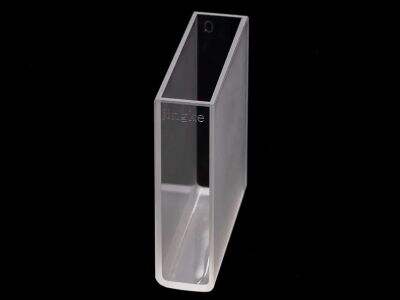Have you ever wondered how the material of a tiny piece of scientific equipment, called a cuvette, can affect how we measure fluorescent light? In this experiment we create our own fluorescence measurements and learn how the type of cuvette material can also impact how accurate our measurements are.
What is Fluorescence?
Fluorescence occurs when some materials absorb energy as light, then emit it as light of a different color. Fluorescence measurements are how scientists get a view of various materials, such as DNA or proteins, by shining a special type of light on them and measuring the response, the light that comes off.
How Cuvette Material Matters
With fluorescence measurements in a cuvette, it is crucial on what the cuvette is made of whether we can trust the measurements. Other materials, such as glass, quartz or plastic, can alter the way light passes through the cuvette and lead to different results.
Comparing Cuvette Materials
They’re made of glass and they’re clear, which means it does not absorb very much light, and so experiments are often done using glass cuvettes. But sometimes they create a problem known as autofluorescence -- the cuvette gives off a tiny amount of its own fluorescence that interferes with our readings.
Quartz cuvettes are pricier but offers better clarity and is loss free of the autofluorescence. This also makes them ideal for experiments in which precision is vital.
Plastic cells are less expensive, but are not as transparent as glass or quartz. They can absorb more light, and when we’re dealing with exceedingly tiny quantities of fluorescent things, they may lead to errors in our measurements.
Selecting the Suitable Cuvette Material
Choosing the right cuvette material is crucial to getting reliable and accurate data on your fluorescence. If we use the Quartz Cuvettes that is not for the use with Abs356nm, there can be errors in our measurement, and this means that our results may differ from what we thought and we may end up finding the wrong conclusion.
Scientists must learn about the different cuvette materials to select the right one for their experiment. This is important in order to enable the trustworthiness of the data collected and to come to meaningful results.
Cuvette Material in Fluorescence Experiments
It is a powerful technique in science for studying fluorescence properties of materials. The Optical Cuvettes material, therefore, has the potential to significantly impact the results of these experiments.
With a very clear quartz cuvette for instance you could limit the noise and interference of the background applying to more precise measurements. Conversely, a plastic cuvet that absorbs too much light can cause our data to be inaccurate.
The Importance of Cuvette Material
The above disclosure has highlighted the significance of the Cuvettes material for the precision and dependability of fluorescence measurements. It’s important that scientists be more careful when using cuvettes made from different materials, and select the optimal one for the measurements that are being performed so that the data produced from the such instruments is not only accurate and relevant, but trustworthy.
Table of Contents
- What is Fluorescence?
- How Cuvette Material Matters
- Comparing Cuvette Materials
- Quartz cuvettes are pricier but offers better clarity and is loss free of the autofluorescence. This also makes them ideal for experiments in which precision is vital.
- Selecting the Suitable Cuvette Material
- Cuvette Material in Fluorescence Experiments
- The Importance of Cuvette Material
 EN
EN
 AR
AR
 BG
BG
 HR
HR
 CS
CS
 DA
DA
 NL
NL
 FI
FI
 FR
FR
 DE
DE
 EL
EL
 HI
HI
 IT
IT
 JA
JA
 KO
KO
 NO
NO
 PL
PL
 PT
PT
 RO
RO
 RU
RU
 ES
ES
 SV
SV
 TL
TL
 ID
ID
 LV
LV
 SR
SR
 SK
SK
 UK
UK
 VI
VI
 HU
HU
 MT
MT
 TH
TH
 TR
TR
 FA
FA
 AF
AF
 MS
MS
 GA
GA
 IS
IS
 LA
LA
 KK
KK







